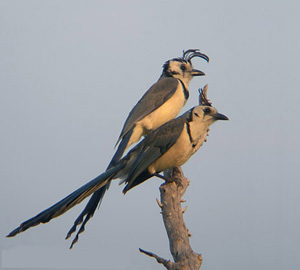
Cyanopica is a genus of magpie in the family Corvidae. They belong to a common lineage with the genus Perisoreus. The generic name is derived from the Latin words cyanos, meaning "lapis lazuli", and pica, meaning "magpie".

Cyanocitta is a genus of birds in the family Corvidae, a family which contains the crows, jays and magpies. Established by Hugh Edwin Strickland in 1845, it contains the following species:

Urocissa is a genus of birds in the Corvidae, a family that contains the crows, jays, and magpies.

Dendrocitta is a genus of long-tailed passerine birds in the crow and jay family, Corvidae. They are resident in tropical South and Southeast Asia. The generic name is derived from the Greek words dendron, meaning "tree," and kitta, meaning "magpie".

Crypsirina is a small genus of long-tailed passerine birds in the crow and jay family, Corvidae. The two species are highly arboreal and rarely come to the ground to feed. The generic name is derived from the Greek words kruptō, meaning "to conceal," and rhis or rhinos, meaning "nostrils".

The four species of avocets are a genus, Recurvirostra, of waders in the same avian family as the stilts. The genus name comes from Latin recurvus, 'curved backwards' and rostrum, 'bill'. The common name is thought to derive from the Italian (Ferrarese) word avosetta. Francis Willughby in 1678 noted it as the "Avosetta of the Italians".

The three dowitchers are medium-sized long-billed wading birds in the genus Limnodromus. The English name "dowitcher" is from Iroquois, recorded in English by the 1830s.

Ovenbirds or furnariids are a large family of small suboscine passerine birds found from Mexico and Central to southern South America. They form the family Furnariidae. This is a large family containing around 315 species and 70 genera. The ovenbird, which breeds in North America, is not a furnariid – rather it is a distantly related bird of the wood warbler family, Parulidae.

The scoters are stocky seaducks in the genus Melanitta. The drakes are mostly black and have swollen bills, the females are brown. They breed in the far north of Europe, Asia, and North America, and winter farther south in temperate zones of those continents. They form large flocks on suitable coastal waters. These are tightly packed, and the birds tend to take off together. Their lined nests are built on the ground close to the sea, lakes or rivers, in woodland or tundra. These species dive for crustaceans and molluscs.

The anis are the three species of birds in the genus Crotophaga of the cuckoo family. They are essentially tropical New World birds, although the range of two species just reaches the United States.

Eared pheasants are pheasants from the genus Crossoptilon in the family Phasianidae.

Guttera is a genus of birds in the family Numididae. Established by Johann Georg Wagler in 1832, it contains four species:

Cyrtonyx is a bird genus in the New World quail family Odontophoridae.

The chestnut-headed tesia is a small insectivorous songbird formerly of the "Old World warbler" family but nowadays placed in the bush warbler family (Cettiidae).

Bubalornis is a genus of bird in the family Ploceidae. Established by Andrew Smith in 1836, it contains the following species:

The spotted barbtail is a species of bird in the family Furnariidae. Its natural habitat is subtropical or tropical moist montane forest.

The white-throated barbtail is an Endangered species of bird in the Furnariinae subfamily of the ovenbird family Furnariidae. It is endemic to Venezuela.

The rusty-winged barbtail is a species of bird in the Furnariinae subfamily of the ovenbird family Furnariidae. It is found in Colombia, Ecuador, Peru, and Venezuela.

The Roraiman barbtail is a species of bird in the Furnariinae subfamily of the ovenbird family Furnariidae. It is found in Brazil, Guyana, and Venezuela.

The magpie-jays are a genus, Calocitta, of the family Corvidae native to the southern part of North America. Sometimes placed in the genus Cyanocorax. The two known species are known to form hybrids.




















